
Revolutionizing the Screen Industry: The Superiority of QDEL over OLED in Tomorrow's Devices

Revolutionizing the Screen Industry: The Superiority of QDEL over OLED in Tomorrow’s Devices
Key Takeaways
- QDEL screen technology has the potential to surpass OLED in terms of color gamut while being less prone to burn-in.
- The main challenges for QDEL displays are improving the lifespan of the blue quantum dots used in QDEL panels, and scaling up QDEL panel manufacturing.
- Mass production of QDEL panels could start as early as 2026, but we might not see QDEL TVs and monitors until 2027 or 2028.
At the moment, OLED is the best consumer-grade display technology on the market. But soon, this could change! Enter QDEL—a display technology that uses self-emitting quantum dots to produce an image on par or better than what’s possible with OLED.
What Is QDEL, and How Does It Work?
QDEL, an abbreviation for “quantum dot electroluminescent,” is also known as “QD-EL” and “nanoLED.” The tech is based on self-emitting quantum dots, which differ from quantum dots seen in QD-OLED and QLED displays in that they emit their own light, thus the self-emitting part in “self-emitting quantum dots.”
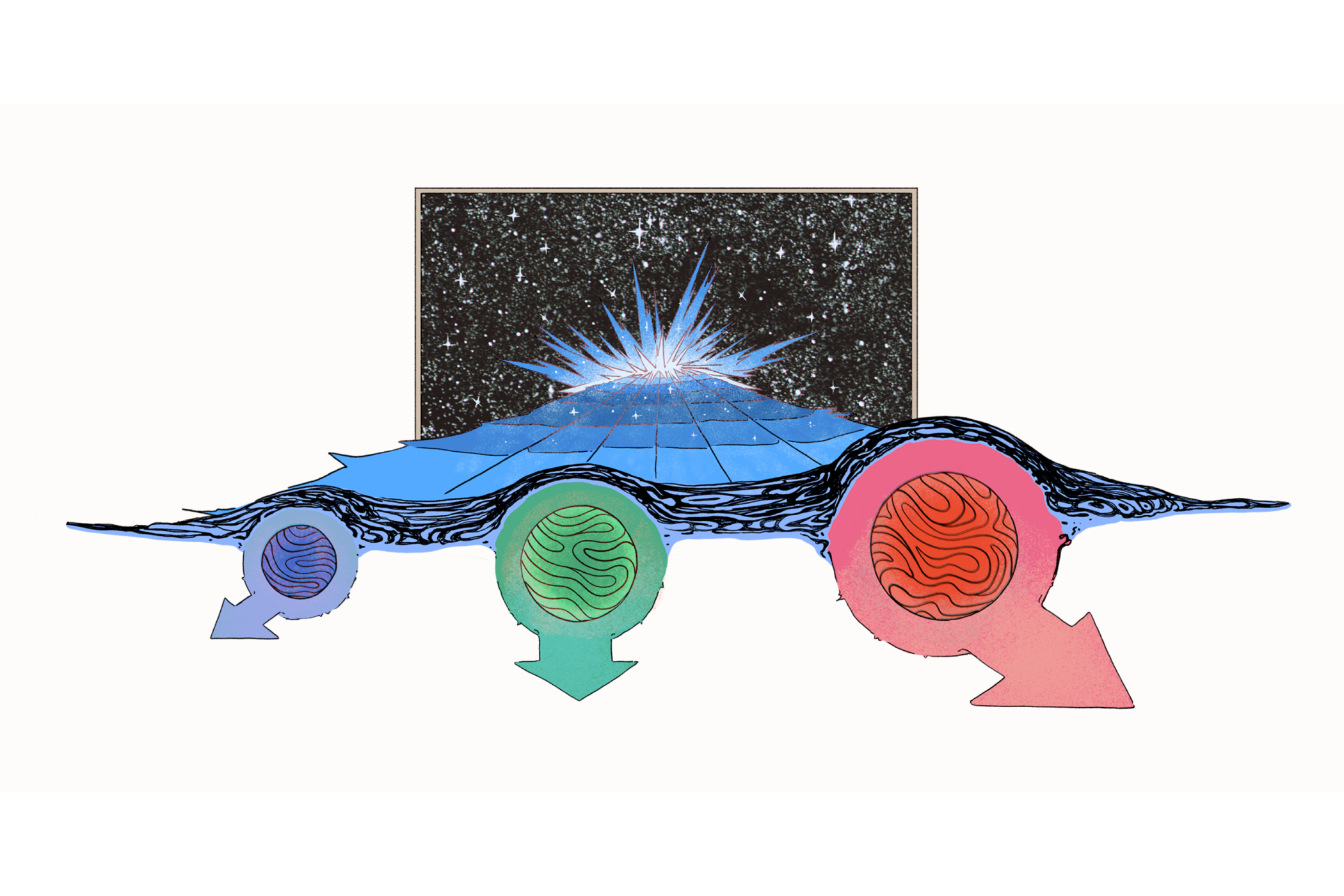
Nanosys
As you can see below, technologies that utilize quantum dots, namely QLED and QD-OLED , use quantum dots to produce more vibrant colors than regular LCD and OLED displays. In the case of QLED displays, which combine quantum dots with a mini-LED backlight layer, you also get higher contrast compared to edge-lit LCD panels. The next step is using only self-emitting quantum dots, which produce color and backlight without the need for an LCD or a blue OLED layer, nor a backlight layer, thus allowing for thinner displays with a wider color gamut.
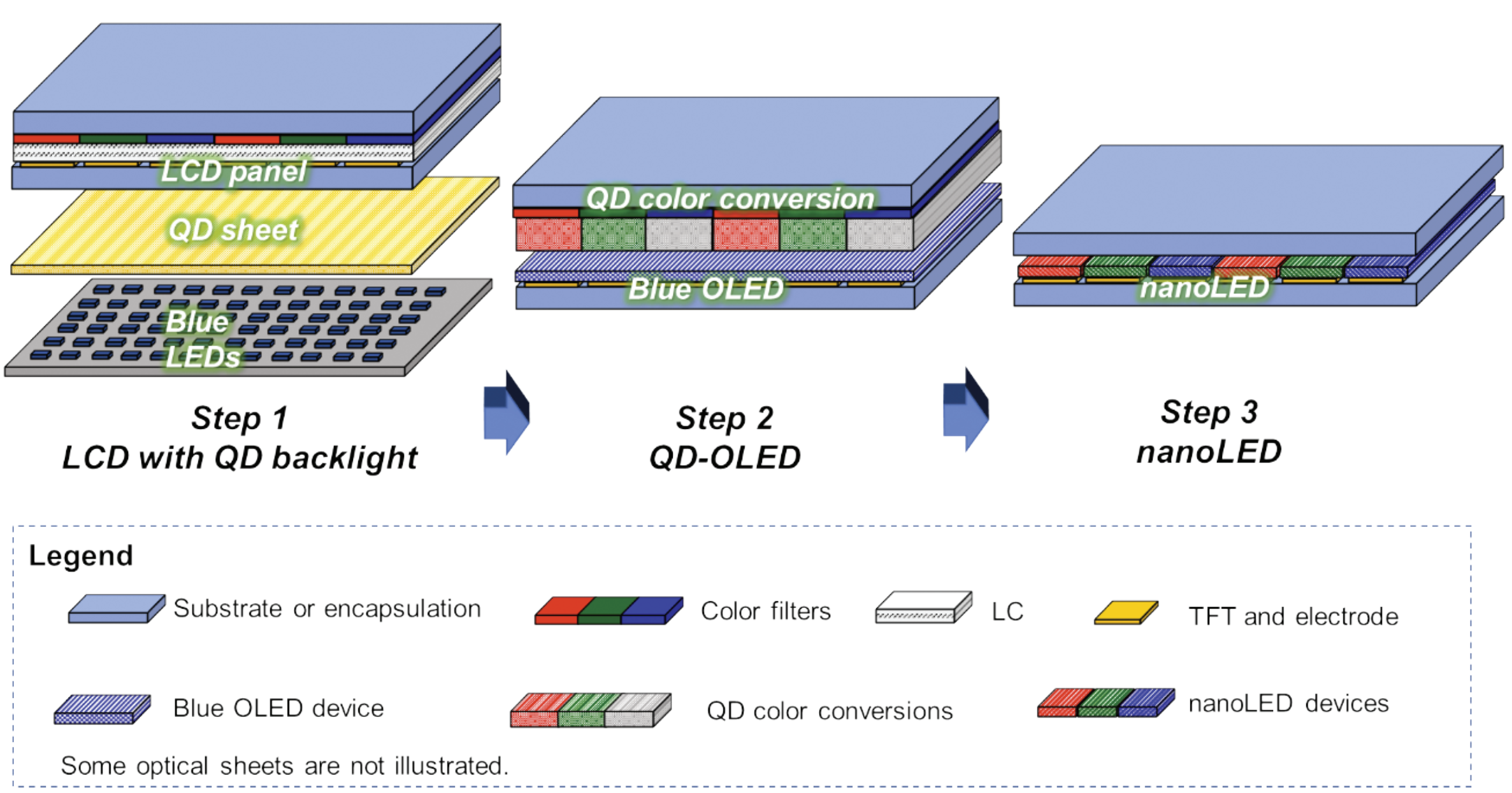
Ishida et al./Information Display
According to a TCL representative, who you can listen to in the video below courtesy of the Charbax YouTube channel, the current inkjet printing QDEL technology allows for a maximum brightness of up to 350 nits and a pixel density higher than 200ppi. Other specs include an OLED-like response time of less than 1 ms and a practically infinite contrast ratio. There’s also a 120Hz refresh rate and greater than 85% coverage of the BT2020 (also known as Rec 2020) color space . These are impressive specs, but there are reasons QDEL displays aren’t available for purchase yet.
The main obstacle to overcome is the lifespan of QDEL displays, particularly the longevity of the blue quantum dots used in QDEL panels, which troubles OLED and QD-OLED panels as well. This applies to quantum dots with cadmium, found in QDEL displays made by TCL, and to cadmium-free quantum dot displays, currently developed by Nanosys and Sharp. Sharp demonstrated a QDEL display prototype at CES 2024, which you can check out below.
Cadmium-free quantum dots also have issues with the lifespan of green quantum dots. That said, the lifespan of blue quantum dots is far shorter , barely surpassing 10,000 hours, whereas green QDs can last for almost 100,000 hours. The reason behind this is that blue quantum dots have the shortest wavelength of the three quantum dot flavors, thus requiring the highest amount of energy to emit light, which leads to faster degradation compared to the red and green quantum dots.
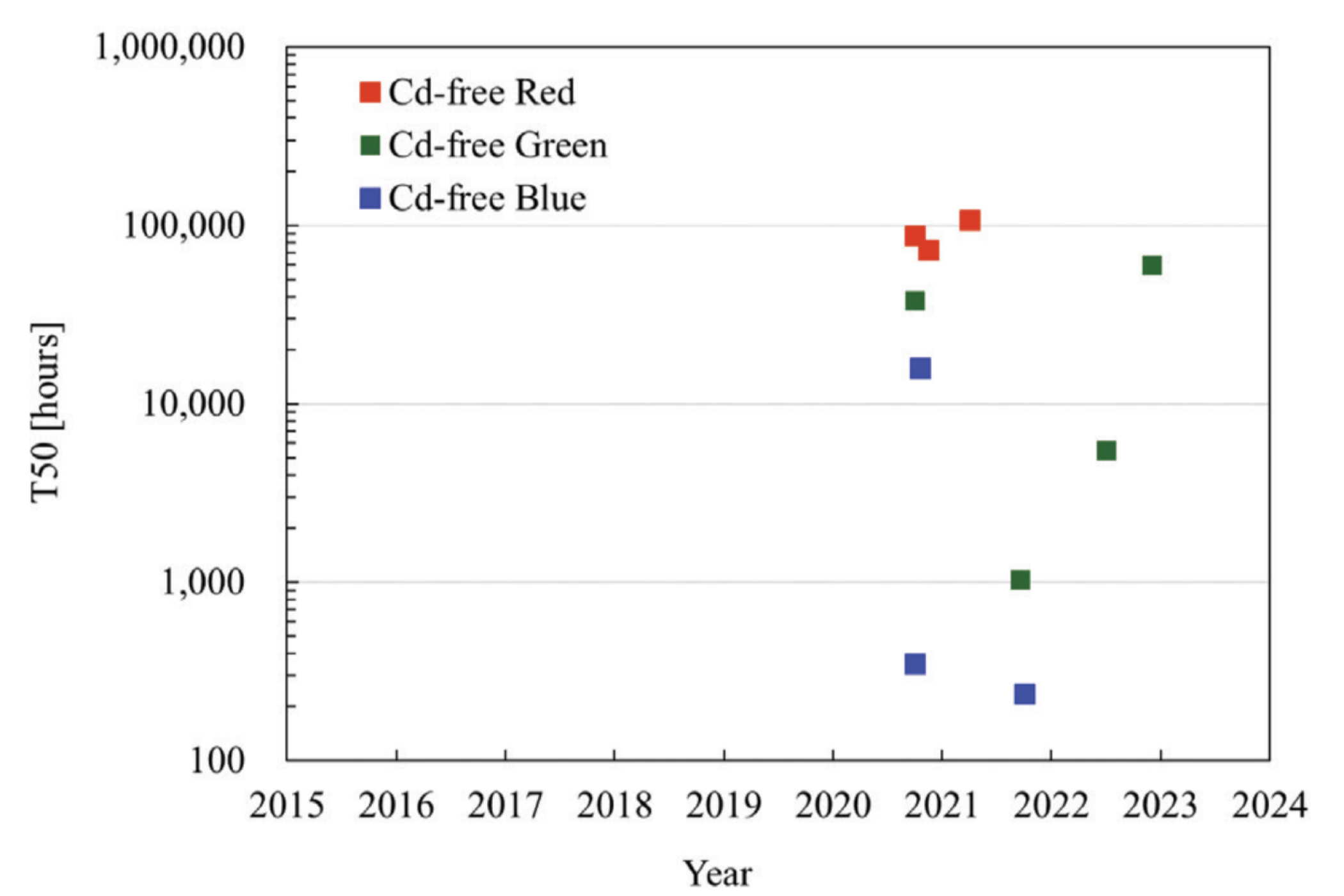
Ishida et al./Information Display
While the QD lifespan has improved in recent years, scaling the manufacturing of QDEL panels is yet another hurdle QDEL panel manufacturers need to overcome before the technology enters mass production.
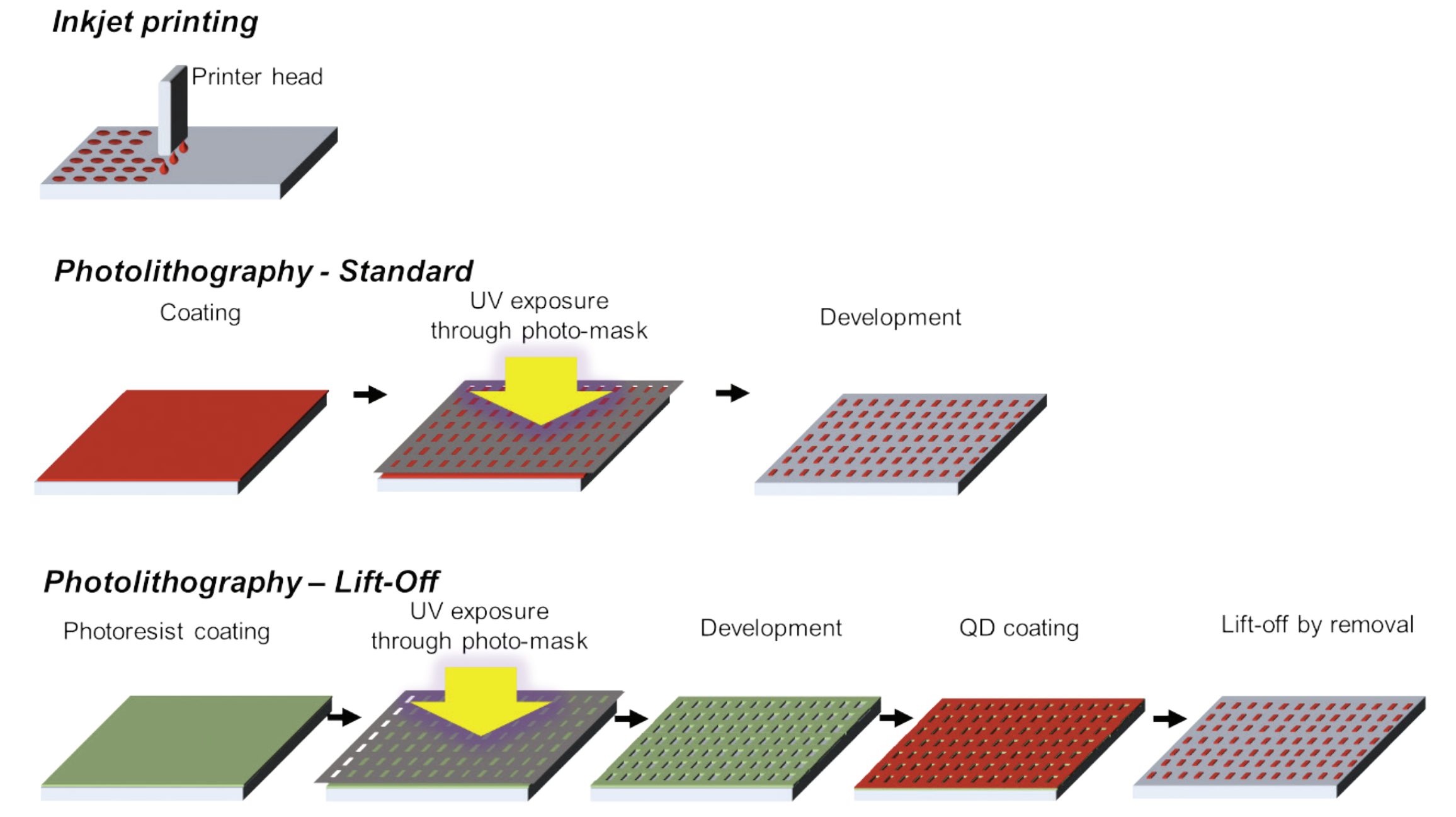
Ishida et al./Information Display
While inkjet printing is the main method of manufacturing QDEL displays right now, its main disadvantage is not being able to produce panels that have a pixel density noticeably higher than 200ppi. Luckily, there’s another method to manufacture QDEL displays—photolithography. This solves the low pixel density issue. This should ultimately result in QDEL displays being suitable for smartphones, smartwatches, and VR headsets.
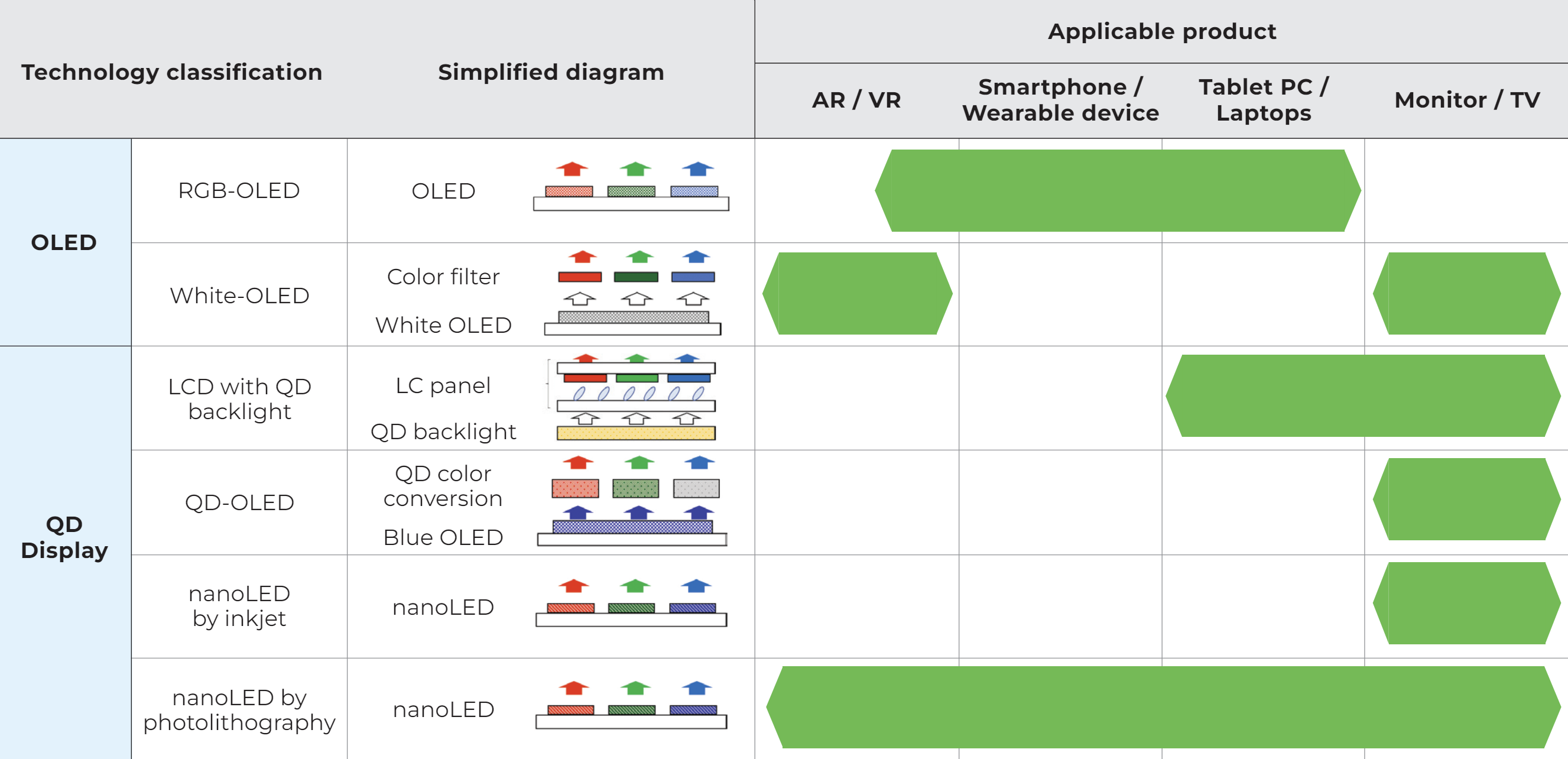
Ishida et al./Information Display
How Is QDEL Better Than OLED?
QDEL displays are thinner than OLEDs because they use fewer layers than OLED and QD-OLED panels. Also, since quantum dots are inorganic, their lifespan, once the technology matures, ought to be longer than what’s offered by OLED, thus almost completely addressing the issue of burn-in.
Manufacturing-wise, QDEL panels can be manufactured in regular, atmospheric pressure assembly rooms, while most OLED panels have to be made in a vacuum because they use vacuum deposition manufacturing processes, which is one of the reasons why they’re so expensive.
Because QDEL panels use fewer layers, we should also expect wider color gamuts in mass-produced QDEL displays compared to what regular OLED screens are capable of. For example, TCL’s prototype display covers more than 85% of the Rec. 2020 image space, while OLEDs can reproduce up to about 75% of Rec. 2020. The best QD-OLED TVs, though, such as the Samsung S95C, cover nearly 90% of the Rec. 2020 color space.
When Can You Expect QDEL TVs and Monitors?
In early 2023, Nanosys, the company behind the quantum dots used by Samsung and others in their QLED and QD-OLED panels, mentioned 2025 or 2026 as tentative dates for the beginning of mass production of its QDEL panels. In a statement to Ars Technica from April 2024, a Nanosys representative reiterated 2026 as the commercial readiness date for QDEL panels.
Note that this only means we might see QDEL panels by 2026, not QDEL TVs or monitors. It’s up to the TV and monitor manufacturers to bring commercial products using QDEL panels to the market, which will happen at a later date.
For instance, Samsung Display showcased its QD-OLED prototype in 2019, produced the first QD-OLED panel in 2021, and launched the first TVs featuring the technology in 2022, with Dell launching the first QD-OLED monitor, the Dell Alienware AW3423DW , also in 2022.
If we use QD-OLED technology as the point of comparison, it’s safe to assume you won’t see a QDEL TV or monitor until 2027 or 2028 at the earliest. That’s not that far, but it isn’t close enough to wait for QDEL TVs and monitors if you’re in the process of replacing your current TV or monitor. If you need a new TV or monitor now, you can check out our best OLED TV and best computer monitor buying guides. We’ve also got the best gaming TV and best gaming monitor buying guides if you prefer something gaming-centric.
While we’re going to have to wait at least three years before we see QDEL TVs and monitors, the wait will be worth it if the QDEL technology delivers on its promises and offers us OLED-like picture quality without burn-in proneness.
Also read:
- [Updated] 2024 Approved Crystal Clear Capture Amping Up Your Home Studio Recordings
- [Updated] Premiere 10 Battle Royale Titles
- 2024 Approved Beginner's Basics of Video Clarity and Sharpness
- ASUS Laptops on a Steep Discount: Grab Yours at Just $99 During Best Buy's Flash Sale - Insights From ZDNet
- Can the MSI Steam Deck Outshine Rivals and Conquer the Portable Gaming Market? [ZDNet]
- In 2024, What Is a SIM Network Unlock PIN? Get Your HTC Phone Network-Ready
- New Release Alert: EmEditor Pro Version 13 Beta N - Latest Text Editing Software
- The Ultimate Pathway to Creating Metaverse Identities
- Top Budget-Friendly Laptops : Including Models From Lenovo, HP, Asus & Others - Featured on ZDNet
- Top Picks: Unbeatable Laptop Promotions in July 2024 - Discovered
- ZDNet's How-To: Reverting Microsoft Windows Audio Configuration to Factory Settings
- Title: Revolutionizing the Screen Industry: The Superiority of QDEL over OLED in Tomorrow's Devices
- Author: George
- Created at : 2024-12-24 16:11:30
- Updated at : 2024-12-27 18:01:27
- Link: https://hardware-tips.techidaily.com/revolutionizing-the-screen-industry-the-superiority-of-qdel-over-oled-in-tomorrows-devices/
- License: This work is licensed under CC BY-NC-SA 4.0.